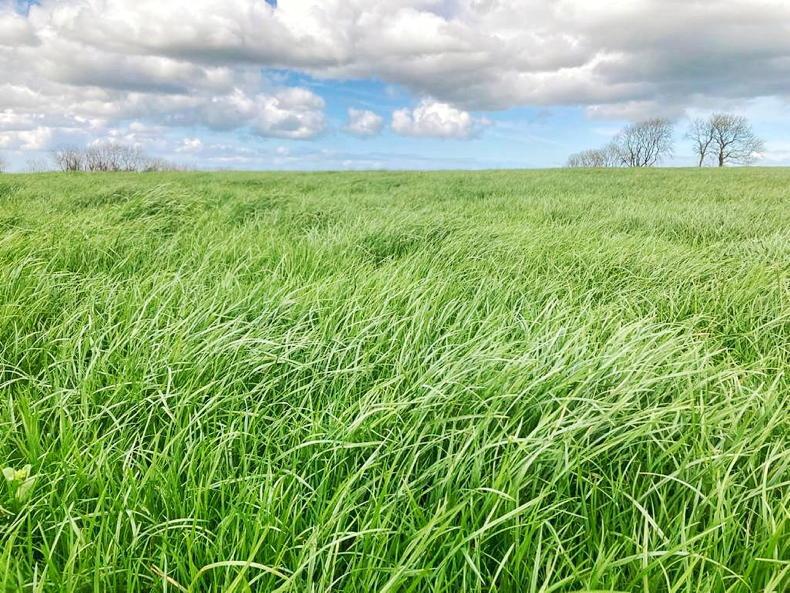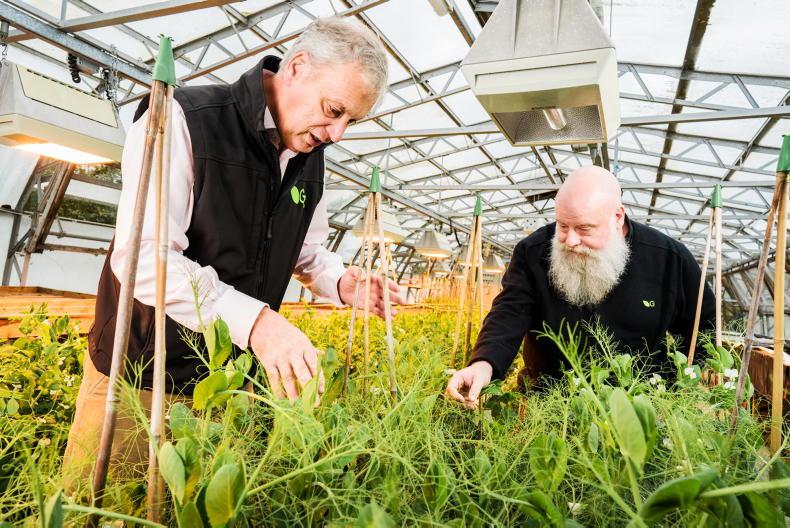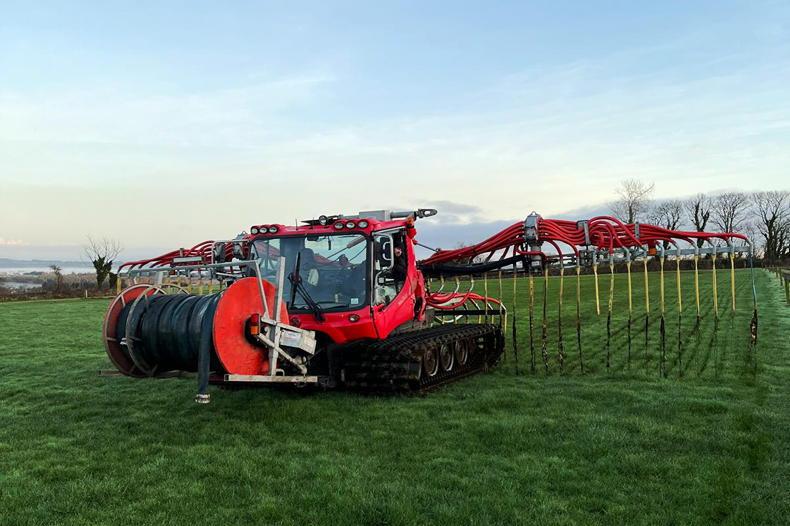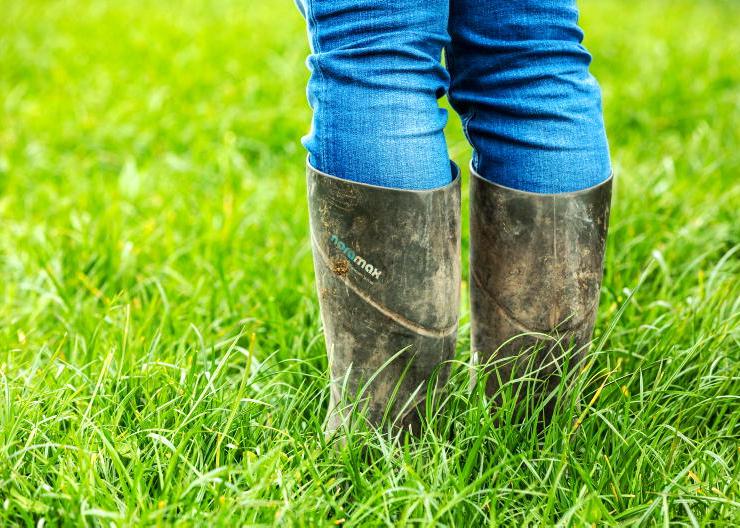After an uncomfortably prolonged period of sub-zero nights, thankfully milder conditions have now prevailed.
Despite the cold weather, slurry that was spread on the home farm via an umbilical system at the beginning of March has yielded a dramatic response. Considering that ground conditions at the time were not suitable for a tanker, and that the cost of hiring the contractor roughly equates to the current value of a sower full of CAN, I consider it to be a good return on investment.
The entire farm has now received an application of both fertiliser (according to soil analysis requirement) and Physiolith, a soil conditioner that is intended to improve soil structure and stimulate plant root development. The theory is that it will allow plants to make the most efficient use of nutrients.
Rolling
I think everyone that has grown up on a family farm has fond memories of Easter school holidays spent rolling grass fields.
For many it was the first tractor job that they performed.
Possibly for this reason I still enjoy it (even if a momentary drop of concentration puts a frustrating bend in an otherwise Wimbledon court-like field).
We try to roll all fields, including those intended for grazing, as not only does it improve plant/soil contact, but as we pre-mow much of our grazing I want the peace of mind that the exercise is not going to destroy a mower bed on a troublesome lump of basalt.
It is also a remarkable achievement to complete a full farm rolling programme without having to make the dreaded phone call for a tow out of a ‘wee sticky patch’.
Spring barley
My father has also ploughed 18 acres for spring barley, although this year we will not undersow the crop.
Our reasoning behind that is by growing a ‘clean’ crop we will have the option of burning off the crop in accordance to weather conditions. And by cutting slightly earlier we hope to be able to direct drill grass seed into the stubble – we have found that to be a more reliable and cost effective means of reseeding than undersowing.
TB
The 24 March was ironic and bitter-sweet for me on the subject of TB, as on the same day that Minister Poots’ TB eradication strategy was approved we had two skin test reactors.
I can only hope this new strategy will mark the beginning of a transformation and that it will lead to a healthier livestock and wildlife population, as well better emotional and mental health of those farming families that must endure its terrible effects.
Consumers
Our challenge will be to communicate to consumers why it is necessary to control TB in wildlife as well as cattle. But more immediately, in a time of tightening household budgets we have a duty to explain why it is necessary that the price of our end product must increase.
While driving though the outskirts of south Belfast recently I was stopped at roadwork traffic lights beside a bus stop, where a young mother was waiting with two children (both looked under 5) and two ‘bags for life’ filled to capacity with groceries.
Perched at the top of one of the bags was a bottle of milk and a pack of beef. This made me think, we as farmers have little idea of the lengths that some of our consumers go to, to obtain our produce. This lady had made a considerable effort to get her children ready, catch a bus to the supermarket, do the shopping and then lug both bags back home.
Consumers deserve our utmost respect for the efforts that they go to in support of our industry. We just can’t tell them to pay more, without clearly explaining why.
Read more
Culling plans in a frustrating spring
The key tasks for this weekend on dairy farms
After an uncomfortably prolonged period of sub-zero nights, thankfully milder conditions have now prevailed.
Despite the cold weather, slurry that was spread on the home farm via an umbilical system at the beginning of March has yielded a dramatic response. Considering that ground conditions at the time were not suitable for a tanker, and that the cost of hiring the contractor roughly equates to the current value of a sower full of CAN, I consider it to be a good return on investment.
The entire farm has now received an application of both fertiliser (according to soil analysis requirement) and Physiolith, a soil conditioner that is intended to improve soil structure and stimulate plant root development. The theory is that it will allow plants to make the most efficient use of nutrients.
Rolling
I think everyone that has grown up on a family farm has fond memories of Easter school holidays spent rolling grass fields.
For many it was the first tractor job that they performed.
Possibly for this reason I still enjoy it (even if a momentary drop of concentration puts a frustrating bend in an otherwise Wimbledon court-like field).
We try to roll all fields, including those intended for grazing, as not only does it improve plant/soil contact, but as we pre-mow much of our grazing I want the peace of mind that the exercise is not going to destroy a mower bed on a troublesome lump of basalt.
It is also a remarkable achievement to complete a full farm rolling programme without having to make the dreaded phone call for a tow out of a ‘wee sticky patch’.
Spring barley
My father has also ploughed 18 acres for spring barley, although this year we will not undersow the crop.
Our reasoning behind that is by growing a ‘clean’ crop we will have the option of burning off the crop in accordance to weather conditions. And by cutting slightly earlier we hope to be able to direct drill grass seed into the stubble – we have found that to be a more reliable and cost effective means of reseeding than undersowing.
TB
The 24 March was ironic and bitter-sweet for me on the subject of TB, as on the same day that Minister Poots’ TB eradication strategy was approved we had two skin test reactors.
I can only hope this new strategy will mark the beginning of a transformation and that it will lead to a healthier livestock and wildlife population, as well better emotional and mental health of those farming families that must endure its terrible effects.
Consumers
Our challenge will be to communicate to consumers why it is necessary to control TB in wildlife as well as cattle. But more immediately, in a time of tightening household budgets we have a duty to explain why it is necessary that the price of our end product must increase.
While driving though the outskirts of south Belfast recently I was stopped at roadwork traffic lights beside a bus stop, where a young mother was waiting with two children (both looked under 5) and two ‘bags for life’ filled to capacity with groceries.
Perched at the top of one of the bags was a bottle of milk and a pack of beef. This made me think, we as farmers have little idea of the lengths that some of our consumers go to, to obtain our produce. This lady had made a considerable effort to get her children ready, catch a bus to the supermarket, do the shopping and then lug both bags back home.
Consumers deserve our utmost respect for the efforts that they go to in support of our industry. We just can’t tell them to pay more, without clearly explaining why.
Read more
Culling plans in a frustrating spring
The key tasks for this weekend on dairy farms









SHARING OPTIONS